|
 CPA is critical because laser pulses of extremely high power density (gigawatts/centimeter2, or GW/cm2)
can severely damage optical components such as amplifiers, lenses, and
mirrors. With CPA technology, it became possible to generate very short
laser pulses with extremely high peak powers by stretching a low-energy
laser pulse more than 10,000 times its duration prior to amplification
and then recompressing the pulse back to near the original duration
after amplification. Because passage through the laser optics occurs
when the pulse is long, there is no damage. CPA is critical because laser pulses of extremely high power density (gigawatts/centimeter2, or GW/cm2)
can severely damage optical components such as amplifiers, lenses, and
mirrors. With CPA technology, it became possible to generate very short
laser pulses with extremely high peak powers by stretching a low-energy
laser pulse more than 10,000 times its duration prior to amplification
and then recompressing the pulse back to near the original duration
after amplification. Because passage through the laser optics occurs
when the pulse is long, there is no damage.
 Using this technology, the Petawatt laser begins with a broad-bandwidth, low-power pulse lasting less than Using this technology, the Petawatt laser begins with a broad-bandwidth, low-power pulse lasting less than
0.1 picosecond in a temperature-controlled clean room in the basement
of the Nova building. Instead of consisting of a single, very specific
wavelength (color) produced in conventional lasers, these ultrashort
pulses contain a broad spectrum. Before amplification, the short-pulse
beam is sent to the pulse stretcher. Here, the pulse is stretched by
using a diffraction grating to spread out the different wavelengths
(colors), separating each frequency component. By passing each color
through a different optical path length (the red components travel a
shorter length than the blue), the pulse is stretched in time by a
factor of 30,000 to 3 nanoseconds. The pulse is then amplified more
than a trillion times without damaging the laser glass as the pulse
travels through a series of amplifier modules, including a portion of
one arm of the Nova laser for the final amplifier stage.
 After amplification,
the beam is then sent to the vacuum chamber 3 ¥ 11 meters long, where
the pulse is compressed using a pair of diffraction gratings each 74
centimeters in diameter. By reversing the process of the stretcher (now
the red components travel a longer length than the blue), the pulse is
compressed down to less than half a picosecond (nearly its original
duration), thereby increasing its peak power nearly 10,000 times to
more than a petawatt. Such pulses must be compressed in a vacuum
because the irradiance of the beam leaving the second grating is over
700 GW/cm2, far too great to pass through any material (including air) without resulting in damage. After amplification,
the beam is then sent to the vacuum chamber 3 ¥ 11 meters long, where
the pulse is compressed using a pair of diffraction gratings each 74
centimeters in diameter. By reversing the process of the stretcher (now
the red components travel a longer length than the blue), the pulse is
compressed down to less than half a picosecond (nearly its original
duration), thereby increasing its peak power nearly 10,000 times to
more than a petawatt. Such pulses must be compressed in a vacuum
because the irradiance of the beam leaving the second grating is over
700 GW/cm2, far too great to pass through any material (including air) without resulting in damage.
The Grating Challenge
 One of the most
challenging tasks was the fabrication of pulse compression gratings of
sufficient size, optical quality, and ability to withstand the enormous
power of the Petawatt laser pulse. Said Perry, "When the project began,
there wasn't a facility in the world capable of making the required
gratings, so we created one." One of the most
challenging tasks was the fabrication of pulse compression gratings of
sufficient size, optical quality, and ability to withstand the enormous
power of the Petawatt laser pulse. Said Perry, "When the project began,
there wasn't a facility in the world capable of making the required
gratings, so we created one."
 The diffraction
gratings that are used in the Petawatt laser are nearly 1 meter in
diameter, some eight times larger and twice as resistant to damage as
the previous state of the art. Livermore's successful development of
diffraction grating technology for the Petawatt led to the selection of
gratings for many uses on the National Ignition Facility (NIF), a
192-beam laser facility planned for Livermore. The diffraction
gratings that are used in the Petawatt laser are nearly 1 meter in
diameter, some eight times larger and twice as resistant to damage as
the previous state of the art. Livermore's successful development of
diffraction grating technology for the Petawatt led to the selection of
gratings for many uses on the National Ignition Facility (NIF), a
192-beam laser facility planned for Livermore.
 Initially, achieving
a petawatt of peak power was expected to require an entirely new
optical component--a high-efficiency, multilayer dielectric grating.
That advanced technology was developed by the Petawatt team in 1993 and
1994, an achievement recognized in 1994 with an R&D 100 Award.
However, the dielectric gratings were not used in the current
experiments because new metallic gratings developed by the team have
proven satisfactory for petawatt pulses at 0.5-picosecond durations.
These metallic gratings are simpler to manufacture than the multilayer
gratings. Multilayer gratings would be required to achieve the
multikilojoule pulses necessary to achieve ignition if fast-ignitor
capability is added to the NIF. Interestingly, the multilayer
dielectric grating technology has already produced its own spinoff.
(See this and other spinoff technologies discussed in the box below.) Initially, achieving
a petawatt of peak power was expected to require an entirely new
optical component--a high-efficiency, multilayer dielectric grating.
That advanced technology was developed by the Petawatt team in 1993 and
1994, an achievement recognized in 1994 with an R&D 100 Award.
However, the dielectric gratings were not used in the current
experiments because new metallic gratings developed by the team have
proven satisfactory for petawatt pulses at 0.5-picosecond durations.
These metallic gratings are simpler to manufacture than the multilayer
gratings. Multilayer gratings would be required to achieve the
multikilojoule pulses necessary to achieve ignition if fast-ignitor
capability is added to the NIF. Interestingly, the multilayer
dielectric grating technology has already produced its own spinoff.
(See this and other spinoff technologies discussed in the box below.) |
 The extraordinarily
powerful laser is called the Petawatt because the prefix "peta" refers
to a quadrillion, or 1015. The laser reached a peak of 1.25 petawatts
of peak power, about 25% more powerful than expected and more than ten
times the peak power of Lawrence Livermore's Nova laser, the world's
largest. The historic shots shattered the existing record for laser
power (125 trillion watts) by more than a factor of 10, set by
Livermore researchers using a Petawatt prototype during the summer of
1995.
The extraordinarily
powerful laser is called the Petawatt because the prefix "peta" refers
to a quadrillion, or 1015. The laser reached a peak of 1.25 petawatts
of peak power, about 25% more powerful than expected and more than ten
times the peak power of Lawrence Livermore's Nova laser, the world's
largest. The historic shots shattered the existing record for laser
power (125 trillion watts) by more than a factor of 10, set by
Livermore researchers using a Petawatt prototype during the summer of
1995. Although the shots
exceeded by more than 1,200 times the entire electrical generating
capacity of the U.S., they lasted less than half a picosecond (a
trillionth, or 10-12, of a second). In that exceedingly
fleeting moment, nearly 10,000 times shorter than the typical Nova
laser shot, only enough energy (about 600 joules) was generated to keep
a 100-watt light bulb burning for about 6 seconds.
Although the shots
exceeded by more than 1,200 times the entire electrical generating
capacity of the U.S., they lasted less than half a picosecond (a
trillionth, or 10-12, of a second). In that exceedingly
fleeting moment, nearly 10,000 times shorter than the typical Nova
laser shot, only enough energy (about 600 joules) was generated to keep
a 100-watt light bulb burning for about 6 seconds. By crossing the
petawatt threshold, the laser heralds a new age in laser research.
Lasers that provide a petawatt of power or more in a picosecond may
make it possible to achieve fusion using significantly less energy than
presently envisioned, through a novel Livermore concept called fast
ignition. (See Science & Technology Review, September 1995,
for more information.) The Petawatt laser will also enable researchers
to study the fundamental properties of matter, thereby aiding the
Department of Energy's stockpile stewardship efforts and opening
entirely new physical regimes to study.
By crossing the
petawatt threshold, the laser heralds a new age in laser research.
Lasers that provide a petawatt of power or more in a picosecond may
make it possible to achieve fusion using significantly less energy than
presently envisioned, through a novel Livermore concept called fast
ignition. (See Science & Technology Review, September 1995,
for more information.) The Petawatt laser will also enable researchers
to study the fundamental properties of matter, thereby aiding the
Department of Energy's stockpile stewardship efforts and opening
entirely new physical regimes to study. Coincidentally,
University of California at Berkeley professor Charles Townes was
visiting the Laboratory on the same day, May 23, as a member of a panel
reviewing the Laser Programs (see Figure 1). Townes was awarded the
Nobel Prize in 1964 for co-inventing the first laser, which generated
only a few thousandths of a watt.
Coincidentally,
University of California at Berkeley professor Charles Townes was
visiting the Laboratory on the same day, May 23, as a member of a panel
reviewing the Laser Programs (see Figure 1). Townes was awarded the
Nobel Prize in 1964 for co-inventing the first laser, which generated
only a few thousandths of a watt.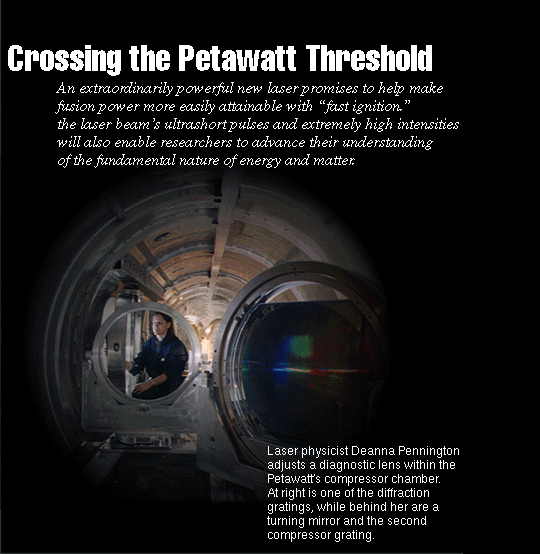
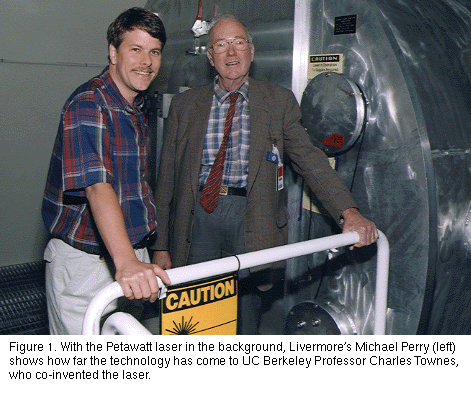
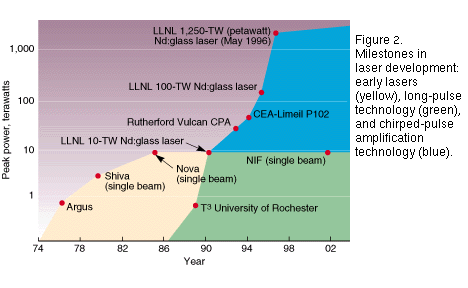

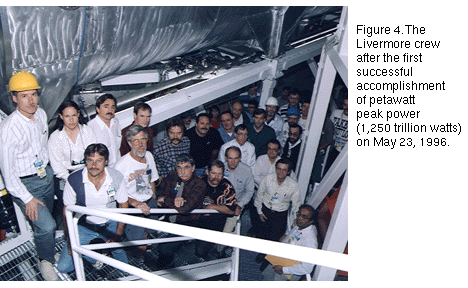
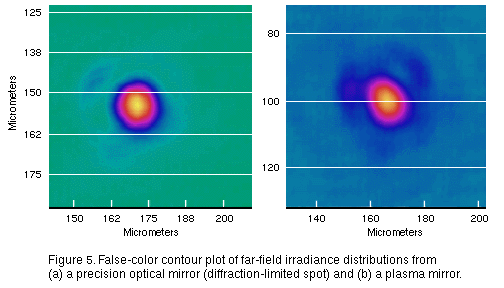


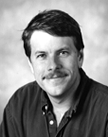 MICHAEL PERRY joined
Lawrence Livermore National Laboratory as a physicist in October 1987.
He is a graduate of the University of California at Berkeley with a
B.S. in both nuclear engineering and chemical engineering (Summa Cum
Laude, 1983), an M.S. in nuclear engineering (1984), and a Ph.D. in
nuclear engineering/physics (1987). He is currently the leader of the
Petawatt Laser Project and Associate Program Leader for Short-Pulse
Lasers, Applications, and Technology. He has authored more than 70
professional publications.
MICHAEL PERRY joined
Lawrence Livermore National Laboratory as a physicist in October 1987.
He is a graduate of the University of California at Berkeley with a
B.S. in both nuclear engineering and chemical engineering (Summa Cum
Laude, 1983), an M.S. in nuclear engineering (1984), and a Ph.D. in
nuclear engineering/physics (1987). He is currently the leader of the
Petawatt Laser Project and Associate Program Leader for Short-Pulse
Lasers, Applications, and Technology. He has authored more than 70
professional publications.